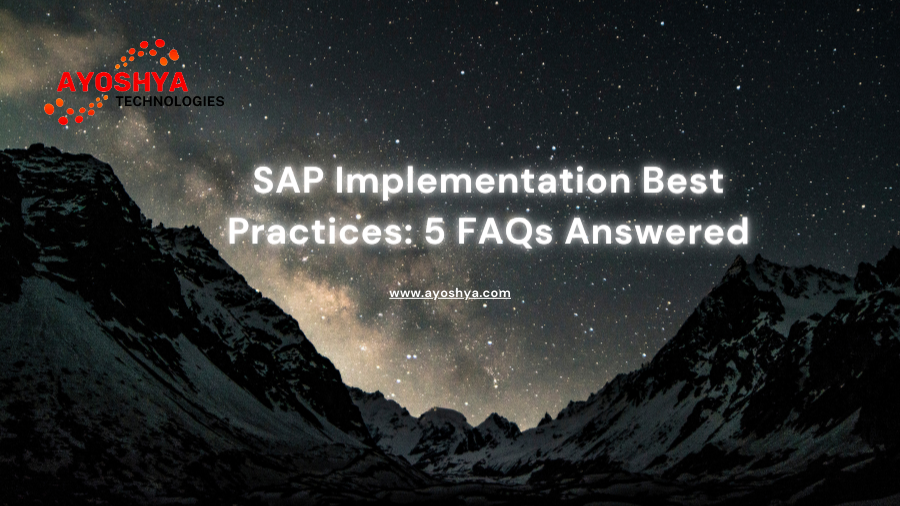SAP Implementation: A Comprehensive Guide to Success
Introduction
In today’s fast-paced business environment, SAP (Systems, Applications, and Products) is a leading enterprise resource planning (ERP) system that helps organizations streamline their operations, manage resources efficiently, and drive business growth. However, implementing SAP successfully is no small feat. This article is your comprehensive guide to SAP implementation, covering everything from planning and preparation to the key steps involved.
Understanding SAP Implementation
What is SAP Implementation ?
SAP implementation is the process of integrating and customizing the SAP ERP software to meet the specific needs and requirements of an organization. It involves configuring SAP modules, migrating data, and ensuring that the system aligns with business processes.
The Significance of Implementation
Why SAP Implementation Matters ?
SAP implementation is a critical milestone for businesses for the following reasons:
1. Process Optimization
Implementing SAP allows organizations to optimize their business processes, improving efficiency and productivity.
2. Data Centralization
SAP centralizes data, providing a single source of truth for all departments, which enhances data accuracy and reliability.
3. Competitive Edge
Companies that successfully implement SAP gain a competitive edge by making informed decisions based on real-time data.
Key Phases of Implementation
Phases of SAP Implementation
SAP implementation is typically divided into several phases:
1. Project Preparation
During this phase, the project team is formed, and project goals and objectives are defined. Initial planning and budgeting are also conducted.
2. Business Blueprint
The business blueprint phase involves mapping the organization’s business processes to SAP functionalities. This phase lays the foundation for system configuration.
3. Realization
In the realization phase, the actual configuration and customization of SAP modules take place. It involves defining user roles, workflows, and data migration.
4. Testing
Thorough testing, including unit testing, integration testing, and user acceptance testing, is crucial to ensure that the SAP system works as intended.
5. Deployment
During deployment, the SAP system is rolled out to end-users. Training and support are provided to ensure a smooth transition.
6. Post-Implementation Support
After deployment, ongoing support and maintenance are essential to address issues and make necessary improvements.
Best Practices for Successful SAP Implementation
Ensuring Implementation Success
To ensure a successful implementation, consider these best practices:
1. Executive Sponsorship
Secure strong executive sponsorship to provide leadership and support throughout the implementation process.
2. Skilled Project Team
Assemble a skilled and experienced project team that includes SAP experts, business analysts, and change management professionals.
3. Clear Communication
Maintain clear and open communication with all stakeholders to manage expectations and address concerns.
4. Data Quality
Ensure data quality by cleansing and migrating data accurately to prevent issues post-implementation.
5. User Training
Invest in comprehensive user training to empower employees to make the most of the SAP system.
Conclusion
It is a complex but rewarding journey for organizations seeking to optimize their operations and stay competitive. By understanding the phases, best practices, and significance of implementation, businesses can embark on this transformational journey with confidence.
FAQs
Q1: How long does SAP implementation typically take?
A1: The duration of SAP implementation varies depending on the scope and complexity of the project. It can take anywhere from several months to a couple of years.
Q2: What are the common challenges in implementation?
A2: Common challenges include data migration issues, resistance to change, and ensuring alignment with business processes.
Q3: Is SAP implementation only for large enterprises?
A3: No, SAP offers solutions for businesses of all sizes, and smaller organizations can benefit from SAP’s capabilities.
Q4: What are the costs associated with implementation?
A4: The costs of SAP implementation include software licensing, consulting services, hardware, training, and ongoing maintenance.
Q5: How can organizations measure the ROI of implementation?
A5: ROI can be measured by evaluating increased productivity, cost savings, and improved business processes resulting from implementation.



